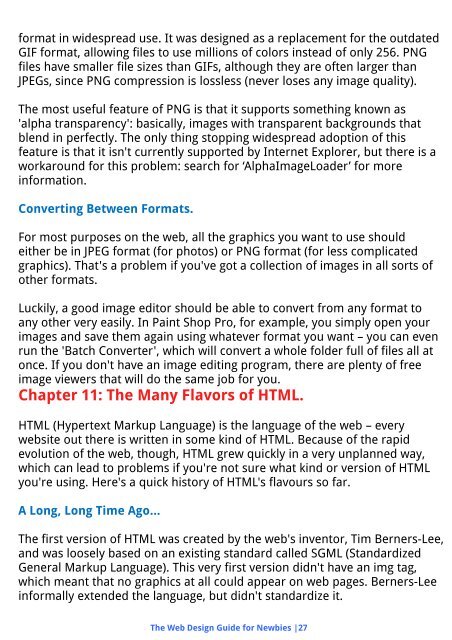You also want an ePaper? Increase the reach of your titles
YUMPU automatically turns print PDFs into web optimized ePapers that Google loves.
format in widespread use. It was designed as a replacement for the outdated<br />
GIF format, allowing files to use millions of colors instead of only 256. PNG<br />
files have smaller file sizes than GIFs, although they are often larger than<br />
JPEGs, since PNG compression is lossless (never loses any image quality).<br />
The most useful feature of PNG is that it supports something known as<br />
'alpha transparency': basically, images with transparent backgrounds that<br />
blend in perfectly. The only thing stopping widespread adoption of this<br />
feature is that it isn't currently supported by Internet Explorer, but there is a<br />
workaround for this problem: search for ‘AlphaImageLoader’ for more<br />
information.<br />
Converting Between Formats.<br />
For most purposes on the web, all the graphics you want to use should<br />
either be in JPEG format (for photos) or PNG format (for less complicated<br />
graphics). That's a problem if you've got a collection of images in all sorts of<br />
other formats.<br />
Luckily, a good image editor should be able to convert from any format to<br />
any other very easily. In Paint Shop Pro, for example, you simply open your<br />
images and save them again using whatever format you want – you can even<br />
run the 'Batch Converter', which will convert a whole folder full of files all at<br />
once. If you don't have an image editing program, there are plenty of free<br />
image viewers that will do the same job for you.<br />
Chapter 11: The Many Flavors of HTML.<br />
HTML (Hypertext Markup Language) is the language of the web – every<br />
website out there is written in some kind of HTML. Because of the rapid<br />
evolution of the web, though, HTML grew quickly in a very unplanned way,<br />
which can lead to problems if you're not sure what kind or version of HTML<br />
you're using. Here's a quick history of HTML's flavours so far.<br />
A Long, Long Time Ago...<br />
The first version of HTML was created by the web's inventor, Tim Berners-Lee,<br />
and was loosely based on an existing standard called SGML (Standardized<br />
General Markup Language). This very first version didn't have an img tag,<br />
which meant that no graphics at all could appear on web pages. Berners-Lee<br />
informally extended the language, but didn't standardize it.<br />
The Web Design Guide for Newbies |27


